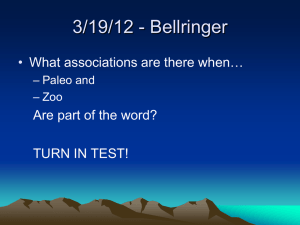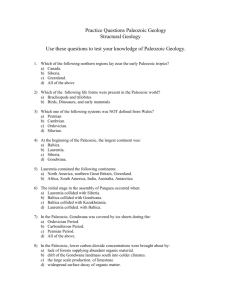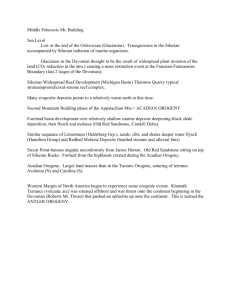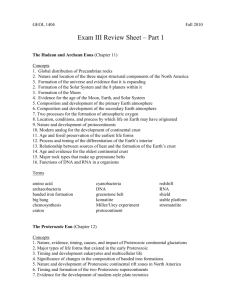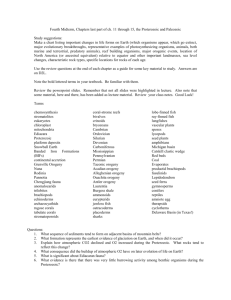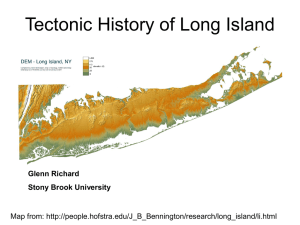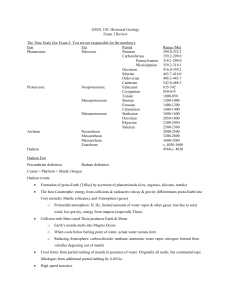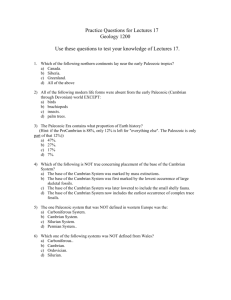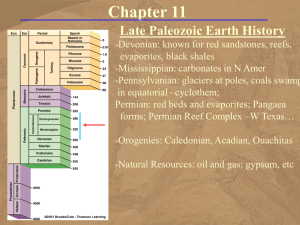3 Paleozoic Geology e
advertisement
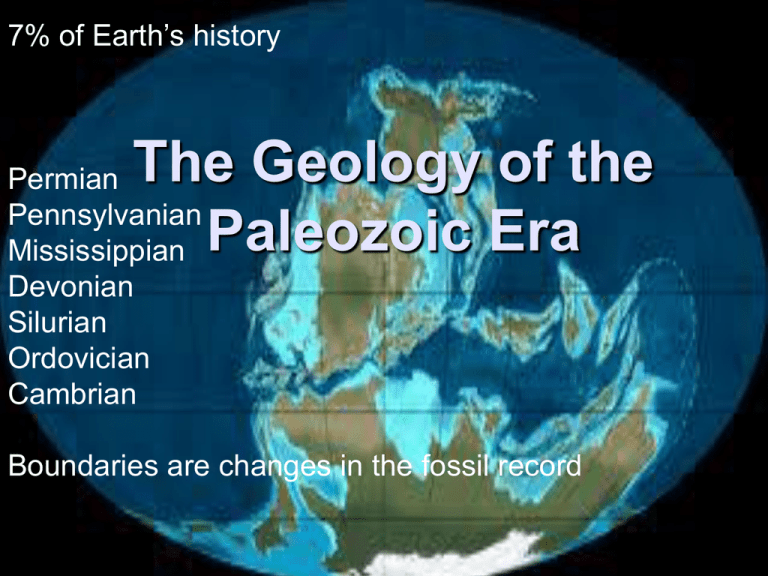
7% of Earth’s history The Geology of the Paleozoic Era Permian Pennsylvanian Mississippian Devonian Silurian Ordovician Cambrian Boundaries are changes in the fossil record Base of the Cambrian system Starts at appearance of first easily visible fossils Boundaries changes in fossils Prof Adam Sedgwick (Cambridge) studied the Cambrian (including the Ordovician) based on superposition and structural geology. Roderick Murchison described and mapped the Silurian based on fossils. Together they defined the Devonian System in Devon and Cornwall. Murchison established the Permian in Russian, then returned and split up Cambrian based on fossils. Later Charles Lapworth separated out the Ordovician. Paleozoic Overview • Global tectonic theme of the Paleozoic assembly of the supercontinent, Pangaea. Rifting raises water, moves plates, which later collide, make foreland basins, water drops • Deposition due to transgressions, and erosion disconformities due to regressions. • Transgressions caused shallow continental (epeiric) seas. Interiors of continents were frequently flooded. • Formation of mountain belts at edges: collisions with small and large landmasses • Collisions resulted in assembly of Pangaea. Paleozoic Global Geology • Six major Paleozoic continents are recognized after Rodinia breakup • Gondwana - S. continents, India • Laurentia - North America, Greenland, part Gr. Britain • Baltica – Northern Europe • Siberia – Most of Northern Asia • Kazakhstania – part Central Asia • China - All of SE Asia and SE China Transgression and Regressions Extinctions: Paleozoic Era key events http://www.fmnh.helsinki.fi/users/haaramo/Meteor_Impacts/Middle_Paleozoic_impacts.htm Rifting raises water, moves plates, which later collide, make foreland basins, water drops Assembly of Deep Pangea Mass Extinction Gondwana/Laurasia Catskill Clastic Wedge Continues subduction Iapetus ; South docks w/ rest of Avalonia Old Red SS Iapetus floor subducted , Laurentia and Baltica collide - Laurasia Avalonia collides with Laurentia Notice: 3 orogenies, 4 transgressions, 2 glaciations, 1 huge mass extinction Devonian Reconstruction High sea levels mostly due large MORs and warm climates (no glaciers) How can we reconstruct past continent positions? • • • • • Paleomagnetism Latitude Biogeography - Distribution of flora and fauna. Climatology - Climate sensitive sediments Tectonic Patterns – continuation of mountains Can’t use Magnetic Stripes on ocean floor- until 200 mya Triassic\Jurassic and later Global paleogeography for the Cambrian period All six continents occur at low paleolatitudes Ocean waters circulate freely/ poles appear ice-free Epeiric seas cover much of continents except Gondwana Highlands in N Gondwana, Eastern Siberia, Central Kazakhistan NOTE: Six major Paleozoic continents are recognized after Rodinia breakup Laurentia - North America, Greenland, Scotland Rotated 90o Baltica - Russia (W of Urals), Scandinavia Siberia - Russia (E of Urals), Part Asia Kazakhstania - Kazakhstan China - All of SE Asia and SE China Gondwana - S. continents, India Ordovician - Silurian SILURIAN – Silurian collision of Baltica/Laurentia Caledonian Orogeny, suturing forms Laurasia ----------------------------------ORDOVICIAN – Ordovician Gondwana moved 40o S to a South Pole location (Glaciers formed, we find L. Ord. tillites) – Baltica moved S, then N – Microcontinent & Island Arcs collided with Laurentia (led to Taconic Orogeny) narrowing Iapetus How do we know? L. Ordovician biogeography of Carolinites genacinaca Confirms paleomagnetic latitudes From McCormick & Fortey 1999. J. Paleontol. 73(2):202-18.) Trilobite Paleogeography Global paleogeography Mid Ordovician to Silurian Siberia moved from equatorial to northern temperate latitudes Small piece of Avalonia hits in Ordovician Baltica moved S, then N and collided with Laurentia. Note rotated 30o Gondwana moved 40o S to a South Pole location (Late Ord. tillites) http://www.geodynamics.no/Platemotions/500-400 M. Ordovician Saucrorthis Mostly distinct faunas Continents were not close Note land at South Pole Devonian – Acadian Orogeny in the Appalachians – Other orogenies: Antler (W. N.Am. Cordillera) and Ellesmere (north margin of Laurentia) – Gondwana moves to higher southern latitudes. All other continents at low northern latitudes. Paleogeography Early Devonian Continued collision of Baltica/Laurentia formed Laurasia, closed Iapetus Ocean Caledonian Orogeny in B/L finishes E. Dev Acadian Orogeny in the Appalachians folds older rocks M. Dev. Antler Caledonian Acadian Other orogenies: Antler (Cordillera) and Ellesmere (north margin of Laurentia) Gondwana moves to higher southern latitudes. All other continents at low northern latitudes. Oklahoma and Morocco Trilobites from the Devonian Looks like Oklahoma was close to Morocco Dalmanitidae Reedops Devonian Faunal Similarities: CONTINENTS CLOSE Dicranurus Final Assembly of Pangea • Permian – Kazakhstania collided with Baltica, forming the Urals • Single continent surrounded by Panthalassa Ocean w Tethys Sea ________________________________________ • Pennsylvanian – Siberia collided with Kazakhstania, forming Altai Mts. • Laurasia collides with Gondwana to reform Appalachians and to form Hercynian Mts. in Late Paleozoic. Hercynian collision forms Europe Gondwana – Laurasia collision Hercynian and Allegheny Orogenies Hercynian Allegheny North and South Europe suture Hercynian Orogeny continuous w Allegheny Orogeny about 300 mya Final Assembly of Pangaea • After the suturing of Gondwana and Laurasia (includes Hercynian and Allegheny Orogenies), • Then: • Siberia collided with Kazakhstania in the Pennsylvanian, forming the Altai Mountains. • Kazakhstania collided with Baltica in the Permian, forming the Ural Mountains. Paleogeography Late Permian Allegheny Orogeny Hercynian N Eur-S Eur Tectonic Details • That’s the overview • Now let’s look in more detail at the collision, i.e. orogenies Angular Unconformity between Martinsburg Fm (mid-Ordovician, folded by Taconic) and overlying Shawangunk Fm (Silurian, folded by Acadian and Allegheny Orogenies) Next let’s look closer at the Orogenies Paleozoic Era key events Rifting raises water, moves plates, which later collide, make foreland basins, water drops Assembly of Pangea Gondwana/Laurasia Catskill Clastic Wedge Continues subd Iapetus South docks rest Avalonia Old Red SS Iapetus floor subducted Scotl Scan NE Can Lauentia and Baltica collide - Laurasia Avalonia collides with Laurentia Tectonics Paleozoic North America • In the Cambrian, several small terranes lay to the south of Laurentia as it separated from Baltica. The shores were passive margins. • In the Ordovician, beginning about 500 mya, the direction of plate motion reversed and Iapetus began to close. Global paleogeography for the Cambrian period Avalonia Terranes Development of the Taconic Orogeny Rodinia breaking up Avalonia Terrane E. Cambrian Plates reverse, in E. Ordovician Laurentia moves toward Avalonia Africa moves toward both Taconic orogeny (cont) Mid – L. Ordovician, N.Avalonia and an island arc dock with Laurentia, beginning the Appalachians Rocks thrust up over margin of Laurentia Interior of Laurentia, Ord.-Silurian • Inland, the Taconic collisions caused the crust to be warped down, forming the Appalachian FORELAND BASIN • Deep water sediments were deposited in the basin, until sediments eroded from the Taconic mountains filled the basin, and shallow water deposits prevailed. • The Queenston Clastic Wedge filled the foreland basin. We saw the Shawangunk and High Falls – Bloomsburg Formations at the Delaware Water Gap. Cambrian paleogeography Pre –collisions Note equator Paleogeography N. Am. M Ord-Sil. Post collisions Barrier Reefs Highstand Evaporites Lowstand Queenston Clastic Wedge Queenston clastic wedge Hardyston Fm (Allentown Dolo., Jacksonburg Ls.) downfolded (Martinsburg Shale) The Caledonian Orogeny • Baltica sutured onto Laurentia – Mountains - Nova Scotia to Scandinavia – Erosion resulted clastic wedge – Devonian Old Red Sandstone • Result called Laurasia Late Silurian - Early Devonian Caledonian Orogeny-Laurasia forms Caledonian Orogeny To our North Baltica sutured onto Laurentia The Acadian Orogeny • Continued subduction of Iapetus ocean floor in Devonian • Additional parts of Avalonia docked with Laurentia – Re-folding of Old Mountains – Virginia to Maritimes – Old rocks even more folded and metamorphosed – Erosion resulted in Catskill clastic wedge – Facies change in foreland basin – shallow marine to streams in Middle Devonian as basin fills – Field trip Marcellus to Mahantango => Centerfield Reef – Catskill delta as basin filled Early - Mid Devonian Acadian Orogeny-Laurasia forms Acadian Orogeny Southern Avalonia into Laurasia Accreted terranes (Does this remind you of somewhere else?) Late Devonian paleogeography of North America Catskill Formation Clastic Wedge from Acadian collision w rest of Avalonia E-Mid Devonian docking, folding. By L. Dev. filled, mostly stream deposits, floodplains have fossils of land plants and amphibians Oxidation state of Iron depended on oxygen levels Catskill clastic wedge thickness Coarse near source Wedge thins away Clastic Wedges fill Foreland Basins Highlands source of sediment BIG Collision with Gondwana The Allegheny Orogeny • • • • Initial contact Late Mississippian Northwest Africa collided Folding of Pennsylvanian rocks proves long duration Deformation much more extensive than the Taconic or Acadian – New York to Alabama Physiographic provinces Appalachians • Piedmont Province: at collision suture, very metamorphosed and intruded • Blue Ridge: Grenvillian rocks thrust toward craton. • Valley and Ridge: northwest thrust faults and northeast anticlines and synclines Thin-skinned tectonics platform rx folded more than basement. Resistant Ridges • Plateau: little deformation Allegheny and Ouachita Orogenies Hercynian Allegheny Ouchita Antler Orogeny • • • In the Devonian, a westward dipping subduction zone formed off Western Laurasia.An Island Arc formed, the Klamath Arc,ocean floor subducted as the arc approached and collided with the continent Late Devonian to Early Mississippian, Basin thrust East Klamath Mts. and North Sierra Nevada Antler Mts. are folded basin sediments, Devonian and Mississippian This is the beginning of Cordillera Construction Late Devonian paleogeography of North America Here it is Paleozoic structure of the West Exposed granite eroded as arkoses (feldspar rich sandstones) Late Paleozoic also saw the beginnings of the Rockies Devonian – Ouachita Orogeny creates compressional stress Pennsylvanian – blocks push up along high angle faults, relieving the stress. PreCambrian basement exposed. Resulted in Front Range Uplift CO & WY Uncompahgre Uplift CO & NM Pennsylvanian arkose, CO Fountain Arkose, CO, deposited northeast of Front Range Uplift Next: Cratonic Sequences • Laurence Sloss: Major transgressive-regressive cycles • 4 in Paleozoic • Allow long range correlation “Sequence Stratigraphy” • Transgression: nearshore sand covered by muds and/or carbonates • Regression: – Nearshore: erosion and disconformity – Far offshore: sediments coarsening upward Transgression and Regressions Paleozoic Era key events Rifting raises water, moves plates, which later collide, make foreland basins, water drops Assembly of Pangea Low High ABS: Sea level rise (cyclic) due Gondwana glaciation Penn-Pm regression due slowdown spreading, assembly of Pangaea, drained continent L Pm KS: filling in of the Appalachian foreland basin by Late Devonian time TC: glacial melting and accelerated sea-floor spreading Sauk: High rates of sea-floor spreading Cambrian – E Ord Sauk Sequence Pre-collision, dramatic transgression due active MORs Note extensive shallow carbonates and equator Time-transgressive Cambrian rocks Grand Canyon Sauk Sequence WEST Transgression Middle Cambrian http://www.geo-tools.com/trilobites.htm Lower Cambrian http://www.wmrs.edu/projects/trilobites/images/trilo7-2.jpg Note how western BAS is older than eastern BAS EAST Tippecanoe Transgression M Ord-Sil. Reworking of Sauk sands gives pure sands useful in glass manufacture. Sands covered by carbonates as transgression advances Michigan Basin surrounded by reefs Restricted circulation caused evaporite precipitation Source of Rock Salt About 5 smaller T-R Pulses Late Devonian Kaskasia Transgression Carbonates over pure sands Williston Basin surrounded by reefs Restricted circulation caused evaporite precipitation Absoroka Sequence • Transgression starts M Pennsylvanian • Regression starts L Pennsylvanian • Cyclothems Reflect Glacial sea-level var. PERMIAN • Inland sea limited to w Texas & s NM • Extensive evaporite deposits KS – OK • Redbeds over interior Climate/Sedimentation Paleozoic Era key events Rifting raises water, moves plates, which later collide and fold. Folding makes deep basin. If fold basin sediments, uplift. Assembly of Pangea Next: Paleozoic Climates • Paleozoic mostly warm, but two glacial times, Ordovician and Pennsylvanian to Late Permian. • Cool Middle Ordovician – CO2 tied up in carbonates – less greenhouse – Extensive Gondwana tillites and striations – Sea level retreats as glacier holds water Late Paleozoic Climates (1) Cool Pennsylvanian – M Permian – CO2 tied up in carbonates – Extensive Gondwana tillites and striations – sea-level fluctuations due glacial (slow regression) and interglacial (fast melt) “cyclothems” – Generated Coal deposits, carbon reservoirs, low CO2 Glacial Abrasion in Bedrock Source: Tom Bean Pennsylvanian Glacier -Gondwana Sea-level falls/rises as glaciers grow/melt Pennsylvanian Cyclothems Rapid transgressions cover swamp as ice melts Coal Swamp swamp estuary Slow regression as ice sheet grows Coal formation Pennsylvania cyclothems Highland source to east Pennsylvanian-age coal deposits Late Paleozoic Climates - 2 (2) The Late Permian WARM • Pangaea was ice-free • Warm equatorial waters from the Panthalassa Ocean reached both poles. • No glaciers = no coal (need rapid transgression due glacial melting) • The Gondwana landmass had drifted north into warmer climates. • reduced coal formation caused carbon dioxide levels to rise • Greenhouse effect L. Permian Pangaea Ice-free, dry interiors, no coal Much of land +/- 30 degrees Pangaea is assembled, sea-level low Hot, dry climate Note evaporites PERMIAN N. America • Inland sea limited to w Texas & s NM • Extensive evaporite deposits KS – OK • Redbeds over interior – strong seasons
